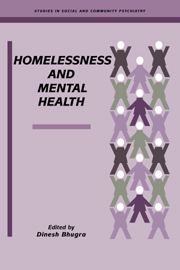Book contents
- Frontmatter
- Contents
- List of contributors
- Preface
- Part I INTRODCTION AND SPECIAL GROUPS
- 1 Introduction
- 2 Homelessness and mental illness: a brief history
- 3 Models of homelessness
- 4 Young homeless and homeless families: a review
- 5 Homeless women
- 6 Homelessness and criminality
- Part II SERVICES
- Part III INTERNATIONAL PERSPECTIVE
- Part IV POLICY AND EVALUATION
- Index
6 - Homelessness and criminality
from Part I - INTRODCTION AND SPECIAL GROUPS
Published online by Cambridge University Press: 15 October 2009
- Frontmatter
- Contents
- List of contributors
- Preface
- Part I INTRODCTION AND SPECIAL GROUPS
- 1 Introduction
- 2 Homelessness and mental illness: a brief history
- 3 Models of homelessness
- 4 Young homeless and homeless families: a review
- 5 Homeless women
- 6 Homelessness and criminality
- Part II SERVICES
- Part III INTERNATIONAL PERSPECTIVE
- Part IV POLICY AND EVALUATION
- Index
Summary
Introduction
The relationship between homelessness, mental disorder and criminal behaviour is complex. Although many homeless people are not mentally disordered and have no criminal history, there is a strong association between homelessness and mental disorder on the one hand and homelessness and criminality on the other. The link between mental disorder and crime is more tenuous and is outside the scope of this chapter although a comprehensive review is provided by Wessely & Taylor (1991).
Theories of causation examining homelessness, mental disorder and crime vary according to ideological standpoint. Whilst criminological theories stress social and economic factors contributing to homelessness such as unemployment, lack of low cost housing and poverty, which in turn lead to mental disorder and crime, a psychological approach tends to focus on individual, intra-psychic factors, for example the onset of mental illness that precipitates homelessness and thence crime. Regardless of ideological perspective, homelessness provides the link between mental disorder and crime, and once an individual has become homeless, for whatever reason, the chances of being overlooked by mental health services or becoming ensnared in the criminal justice system are greatly increased.
This chapter will consider the plight of that most disadvantaged and chaotic group, namely those homeless people who are both mentally disordered and criminal. The historical review shows how homelessness has been criminalized since the Middle Ages as a means of social control. The review of studies of homelessness and criminal- ity supports the strong links that exist with high rates of homelessness amongst prison and psychiatric hospital populations.
- Type
- Chapter
- Information
- Homelessness and Mental Health , pp. 78 - 96Publisher: Cambridge University PressPrint publication year: 1996

